Analysis of a Rainstorm Process in Nanjing Based on Multi-Source Observational Data and Lagrangian Method
Abstract
1. Introduction
2. Data, Instruments, and Methods
3. Precipitation Observation and Circulation Background
3.1. Precipitation Observation
3.2. Circulation Background
4. Analysis of Satellite and Radar Observation
4.1. Characteristics of Mesoscale Convective Cloud Clusters
4.2. Characteristics of Radar Echoes
4.3. Characteristics of Upper and Lower Atmospheric Wind Fields
5. Analysis of Microwave Radiometer and Laser Disdrometer Observation
5.1. Characteristics of Local Water Vapor Variations
5.2. Characteristics of Precipitation Particles during the Meiyu Season
6. Three-Dimensional Characteristics of Water Vapor Transport
7. Conclusions
- The rainstorm process has characteristics of concentrated heavy rainfall, intense short-term precipitation, and large cumulative rainfall. It was a subtropical high-edge-type rainstorm under the background of the northeast cold vortex. The rainstorm area was located in the 200 hPa diversion region, the left front of the low-level jet, and the convergence of cold and warm air flows near the low-level shear line.
- The development of the rainstorm was accompanied by the merging and strengthening of mesoscale convective cloud clusters. The TBB low-value area was expanded, and the intensity of TBB increased, with the lowest TBB ≤ −72 °C. Heavy precipitation occurred near the region of large TBB gradient values or the center of low TBB values on the northern side of the convective cloud cluster, and it moved with the low TBB value areas. The lower the TBB value and the longer the duration, the greater the precipitation intensity and the larger the accumulated rainfall.
- The formation of the train effect during the eastward movement of strong echoes was an important reason for the continuous 3-h heavy rainfall in the central part of Nanjing. The S-band dual-polarization radar showed that KDP, ZDR, and ρHV all increased significantly during the period of heavy precipitation, with KDP reaching 1 to 5 °/km, ZDR reaching 1 to 3.5 dB and ρHV reaching above 0.97, indicating vigorous vertical upward motion during this phase and the precipitation being mainly dominated by dense and uniform large raindrops.
- Wind profiler radar data show that the near-surface wind speed increased about half an hour before the onset of precipitation. The precipitation intensified after the establishment of the southwesterly jet in the middle and lower levels. The period of the strongest precipitation corresponded well with the passage of the upper-level trough and the intrusion of cold air. The vertical structure of the wind field detected by the wind profiler radar provides a good indication of the changes in precipitation intensity.
- Analysis of microwave radiometer data indicates that both water vapor density and liquid water content were maximum in the lower layer during this rainstorm process. The overall water vapor density decreased while the lower layer liquid water content increased during the precipitation period, showing an inverse relationship. The hourly rainfall was negatively correlated with the total column-integrated water vapor content and positively correlated with the total column-integrated liquid water content. Compared to the total column-integrated water vapor content, the total column-integrated liquid water content was more sensitive to changes in rainfall intensity, and its abrupt increase can serve as an important indicator for the onset of heavier rainfall.
- Laser disdrometer data show that during the Meiyu season in Nanjing, convective precipitation was mainly composed of small to medium raindrops with diameters less than 3 mm, with most raindrops being less than 1 mm, and the falling velocities of raindrops mainly concentrated between 2 and 6 m·s−1.
- There were four water vapor channels in this rainstorm process: the mid-latitude westerly channel, the Indian Ocean channel, the South China Sea channel, and the Pacific channel. During the heavy rainfall, the Pacific Ocean water vapor channel was the main channel at the middle and lower levels, while the South China Sea water vapor channel was the main channel at the upper level, both accounting for a trajectory proportion of 34.2%.
Author Contributions
Funding
Institutional Review Board Statement
Informed Consent Statement
Data Availability Statement
Conflicts of Interest
References
- Liu, Y.L.; Zhang, H.X.; Chen, H.T.; Chen, C.Z. Flood impact on urban roads and commuting: A case study of Wuhan, China. Front. Environ. Sci. 2022, 10, 1056854. [Google Scholar] [CrossRef]
- Tabari, H. Climate change impact on flood and extreme precipitation increases with water availability. Sci. Rep. 2020, 10, 13768. [Google Scholar] [CrossRef]
- Pendergrass, A.G. What precipitation is extreme. Science 2018, 360, 1072–1073. [Google Scholar] [CrossRef] [PubMed]
- Trenberth, K.E.; Fasullo, J.T.; O’Dell, C.; Wong, T. Relationships between tropical sea surface temperature and top-of-atmosphere radiation. Geophys. Res. Lett. 2010, 37, L03702. [Google Scholar] [CrossRef]
- Liang, P.; Ding, Y.H. The long-term variation of extreme heavy precipitation and its link to urbanization effects in Shanghai during 1916–2014. Adv. Atmos. Sci. 2017, 34, 321–334. [Google Scholar] [CrossRef]
- Hsieh, Y.P. A preliminary survey of certain rain-bearing systems over China in spring and summer. Acta. Meteorol. Sin. 1956, 1, 1–23. [Google Scholar] [CrossRef]
- Caracena, F.; Fritsch, J.M. Focusing mechanisms in Texas Hill country flash floods of 1978. Mon. Weather. Rev. 1983, 111, 2319–2332. [Google Scholar] [CrossRef][Green Version]
- Zhang, G.S.; Mao, J.Y.; Liu, Y.M.; Wu, G.X. PV perspective of impacts on downstream extreme rainfall event of a Tibetan Plateau vortex collaborating with a Southwest China Vortex. Adv. Atmos. Sci. 2021, 38, 1835–1851. [Google Scholar] [CrossRef]
- Ding, Y.H. Some aspects of rainstorm and meso-scale meteorology. Acta. Meteorol. Sin. 1994, 3, 274–284. [Google Scholar] [CrossRef]
- Peng, J.Y.; Wu, R.S.; Wang, Y. Initiation mechanism of meso-β scale convective systems. Adv. Atmos. Sci. 2004, 19, 870–884. [Google Scholar] [CrossRef]
- Luo, Y.H.; Du, Y. The roles of low-level jets in“21·7”Henan extremely persistent heavy rainfall event. Adv. Atmos. Sci. 2023, 40, 350–373. [Google Scholar] [CrossRef]
- Wei, P.; Xu, X.; Xue, M.; Zhang, C.; Wang, Y.; Zhao, K.; Zhou, A.; Zhang, S.; Zhu, K. On the key dynamical processes supporting the 21.7 Zhengzhou record-breaking hourly rainfall in China. Adv. Atmos. Sci. 2023, 40, 337–349. [Google Scholar] [CrossRef]
- Zhu, D.; Zhi, X.F.; Wang, N.; Chen, C.S.; Tian, X.; Yu, Y.M. Impacts of Changbai Mountain topography on the extreme precipitation from super typhoon Maysak. Front. Environ. Sci. 2022, 9, 818402. [Google Scholar] [CrossRef]
- Xia, R.; Zhang, D. An observational analysis of three extreme rainfall episodes of 19–20 July 2016 along the Taihang Mountains in North China. Mon. Weather. Rev. 2019, 147, 4199–4220. [Google Scholar] [CrossRef]
- Shen, D.D.; Ran, L.K.; Yang, S.A.; Yang, S.; Li, N.; Jiao, B.F. Frontogenetic analyses of the topographic frontal rainstorm in Xinjiang. Chin. J. Atmos. Sci. 2023, 47, 1843–1862. [Google Scholar] [CrossRef]
- Ralph, F.M.; Neiman, P.J.; Wick, G.A. Satellite and CALJet aircraft observations of atmospheric rivers over the eastern North Pacific Ocean during the winter of 1997/98. Mon. Weather. Rev. 2004, 132, 1725–1745. [Google Scholar] [CrossRef]
- Guan, B.; Waliser, D.E. Detection of atmospheric rivers: Evaluation and adaption of an algorithm for global studies. J. Geophys. Res. 2015, 120, 12514–12535. [Google Scholar] [CrossRef]
- Gimeno, L.; Nieto, R.; Vazquez, M.; Lavers, D.A. Atmospheric rivers: A mini−review. Front. Earth. Sci. 2014, 2, 1–6. [Google Scholar] [CrossRef]
- Hu, G.Q.; Ding, Y.H. A study on the energy and water cycles over Changjiang-Huaihe river basins during the 1991 heavy rain periods. Acta. Meteorol. Sin. 2003, 2, 146–163. [Google Scholar] [CrossRef]
- Ding, Y.H.; Liu, Y.J.; Song, Y.F. East Asian summer monsoon moisture transport belt and its impact on heavy rainfalls and floods in China. Adv. Water Sci. 2020, 31, 629–643. [Google Scholar] [CrossRef]
- Liao, J.; Tan, Z.M. Numerical simulation of a heavy rainfall event along the meiyu front: Influences of different scale weather systems. Acta. Meteorol. Sin. 2005, 5, 771–789. [Google Scholar] [CrossRef]
- Zhao, H.; Shu, Y.; Mao, Y.Q.; Liu, Y.; Yu, K. The assimilation effect of multi-new types observation data in the forecasts of meiyu-front rainstorm. Atmosphere 2023, 14, 693. [Google Scholar] [CrossRef]
- Stohl, A.; James, P. A Lagrangian analysis of the atmospheric branch of the global water cycle. Part Ⅰ: Method description, validation, and demonstration for the August 2002 flooding in central Europe. J. Hydrometeorol. 2004, 5, 656–678. [Google Scholar] [CrossRef]
- Stohl, A.; James, P. A Lagrangian analysis of the atmospheric branch of the global water cycle. Part Ⅱ: Moisture transports between earth’ s ocean basins and river catchments. J. Hydrometeorol. 2005, 6, 961–984. [Google Scholar] [CrossRef]
- Dirmeyer, P.A.; Schlosser, C.A.; Brubaker, K.L. Precipitation, recycling, and land memory: An integrated analysis. J. Hydrometeorol. 2009, 10, 278–288. [Google Scholar] [CrossRef]
- Dominguez, F.; Kumar, P.; Liang, X.; Ting, M. Impact of atmospheric moisture storage on precipitatipn recycling. J. Clim. 2006, 19, 1513–1530. [Google Scholar] [CrossRef]
- Guo, L.Y.; Shi, Y.; Jiang, H.R. Comparison of impact and water vaper characteristics between two types of floods in Eastern China. Environ. Res. Lett. 2022, 17, 024039. [Google Scholar] [CrossRef]
- Shi, Y.; Jiang, Z.H.; Li, Z.X. Vertical Characteristics of Water Vapor Transport during the Rainy Season in Eastern China Based on the Lagrangian Method. Chin. J. Atmos. Sci. 2022, 46, 380–392. [Google Scholar] [CrossRef]
- Van, L.N.; Le, X.-H.; Nguyen, G.V.; Yeon, M.; May, D.T.T.; Lee, G. Comprehensive relationships between kinetic energy and rainfall intensity based on precipitation measurements from an OTT Parsivel2 optical disdrometer. Front. Environ. Sci. 2022, 10, 985516. [Google Scholar] [CrossRef]
- Zhou, L.; Dong, X.; Fu, Z.; Wang, B.; Leng, L.; Xi, B.; Cui, C. Vertical distributions of raindrops and Z-R relationships using Microrain Radar and 2-D-Video Distrometer measurements during the Integrative Monsoon Frontal Rainfall Experiment (IMFRE). J. Geophys. Res. 2020, 125, e2019JD031108. [Google Scholar] [CrossRef]
- Zhang, T.; Wei, W.; Wu, L.H. Analysis of the Water Vapor Characteristics of Short-Time Heavy Rainfall in July and August Based on Microwave Radiometer Data. Plateau. Mt. Meteor. Res. 2020, 40, 49–55. [Google Scholar] [CrossRef]
- Chen, J.; Yin, J.; He, W.; Chen, Y.H. Analysis and Application of Wind Profiler Radar Data in a Meiyu Front Rainstorm Weather Process in Jiangxi. Meteor. Disaster Reduct. Res. 2016, 39, 206–215. [Google Scholar] [CrossRef]
- Wang, K.; Xia, X.; Wang, X.H.; Li, M.; Gu, P.S.; Peng, X.Y. Multiscale Analysis of a Record-Breaking Predecessor Rain Event Ahead of Typhoon Danas (2019) in Jiangsu, China. Atmosphere 2023, 14, 1608. [Google Scholar] [CrossRef]
- Shen, F.; Song, L.; Li, H.; He, Z.; Xu, D. Effects of different momentum control variables in radar data assimilation on the analysis and forecast of strong convective systems under the background of northeast cold vortex. Atmos. Res. 2022, 280, 106415. [Google Scholar] [CrossRef]
- Shen, F.; Shu, A.; Liu, Z.; Li, H.; Jiang, L.; Zhang, T.; Xu, D. Assimilating FY-4A AGRI Radiances with a Channel Sensitive Cloud Detection Scheme for the Analysis and Forecast of Multiple Typhoons. Adv. Atmos. Sci. 2023, 41, 937–958. [Google Scholar] [CrossRef]
- Xu, D.; Zhang, X.; Liu, Z.; Shen, F. All-sky infrared radiance data assimilation of FY-4A AGRI with different physical parameterizations for the prediction of an extremely heavy rainfall event. Atmos. Res. 2023, 293, 106898. [Google Scholar] [CrossRef]
- Draxler, R.R.; Hess, G.D. An overview of the HYSPLIT4 modelling system for trajectories. Aust. Meteorol. Mag. 1998, 47, 295–308. [Google Scholar]
- Liu, B.; Guo, J.; Gong, W.; Shi, L.; Zhang, Y.; Ma, Y. Characteristics and performance of wind profiles as observed by the radar wind profiler network of China. Atmos. Meas. Tech. 2020, 13, 4589–4600. [Google Scholar] [CrossRef]
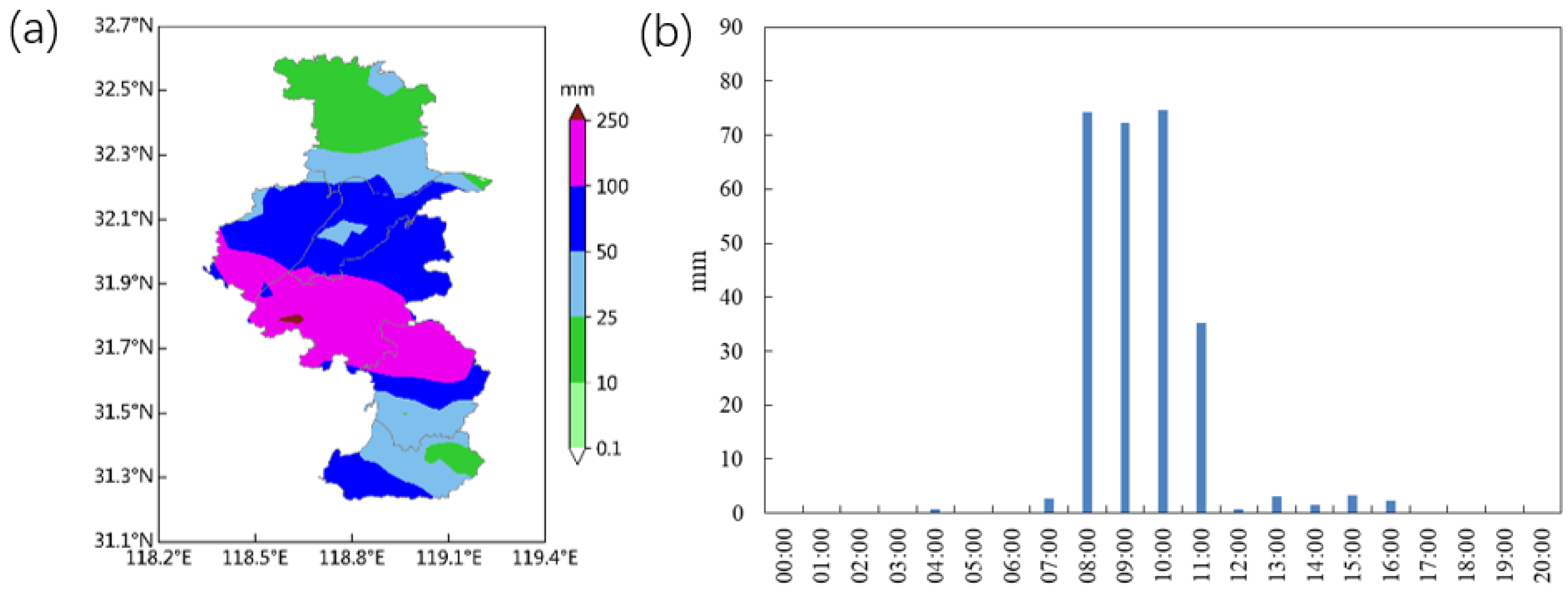


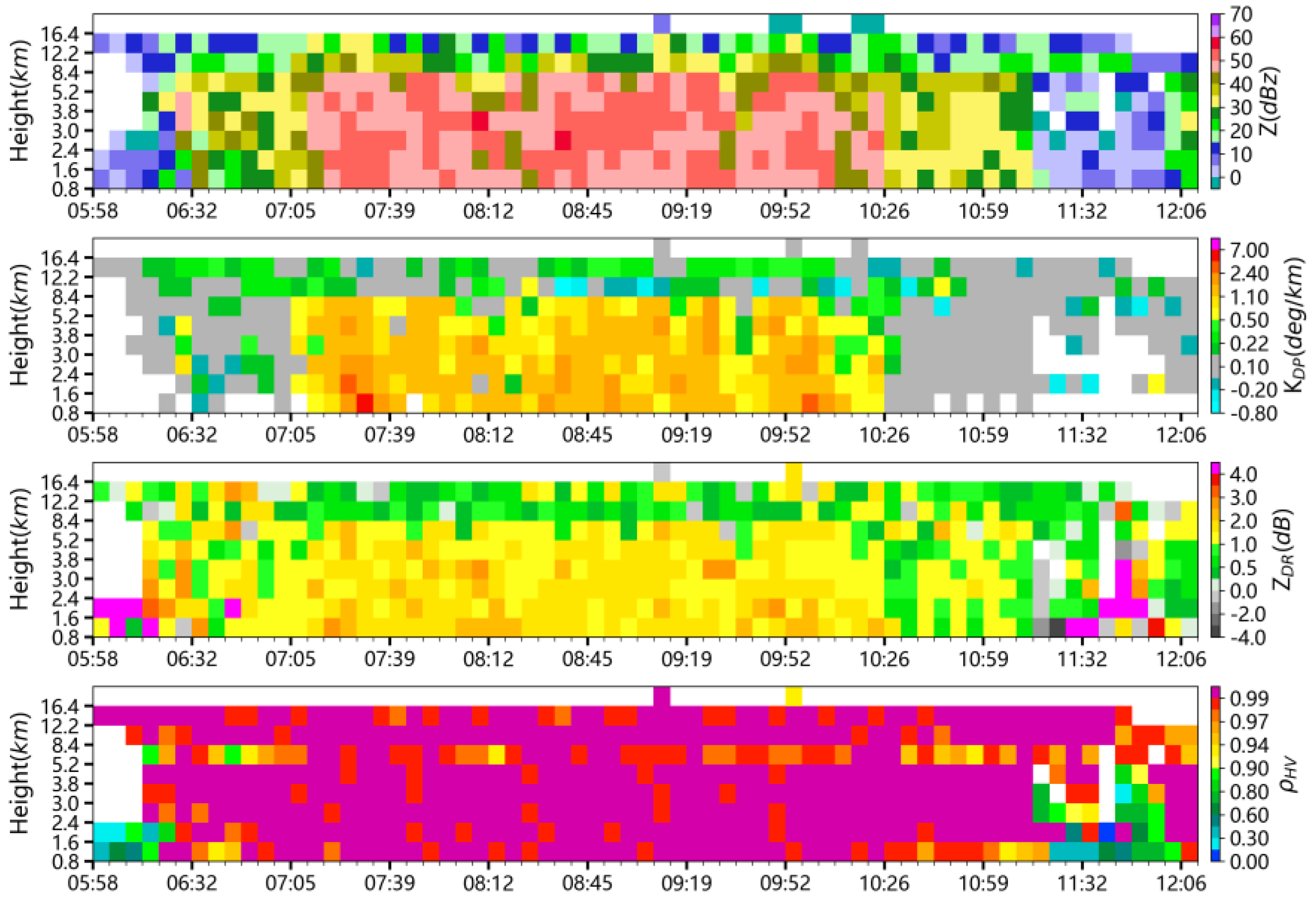
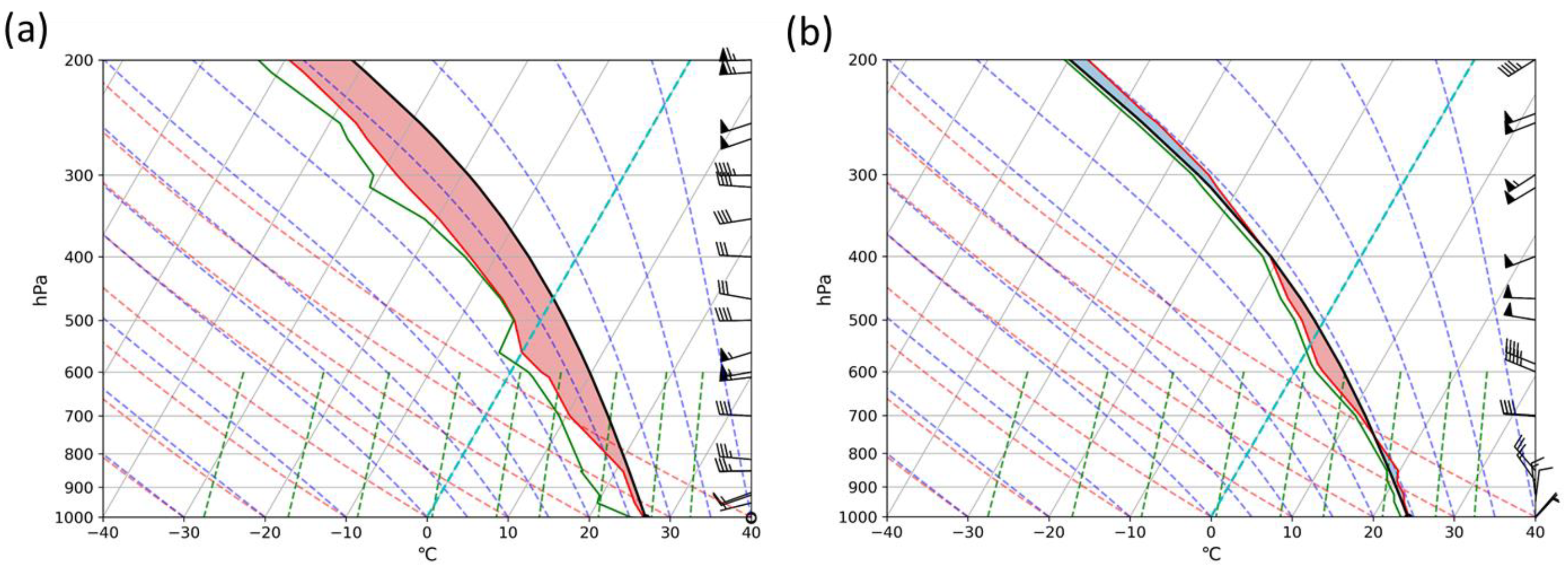

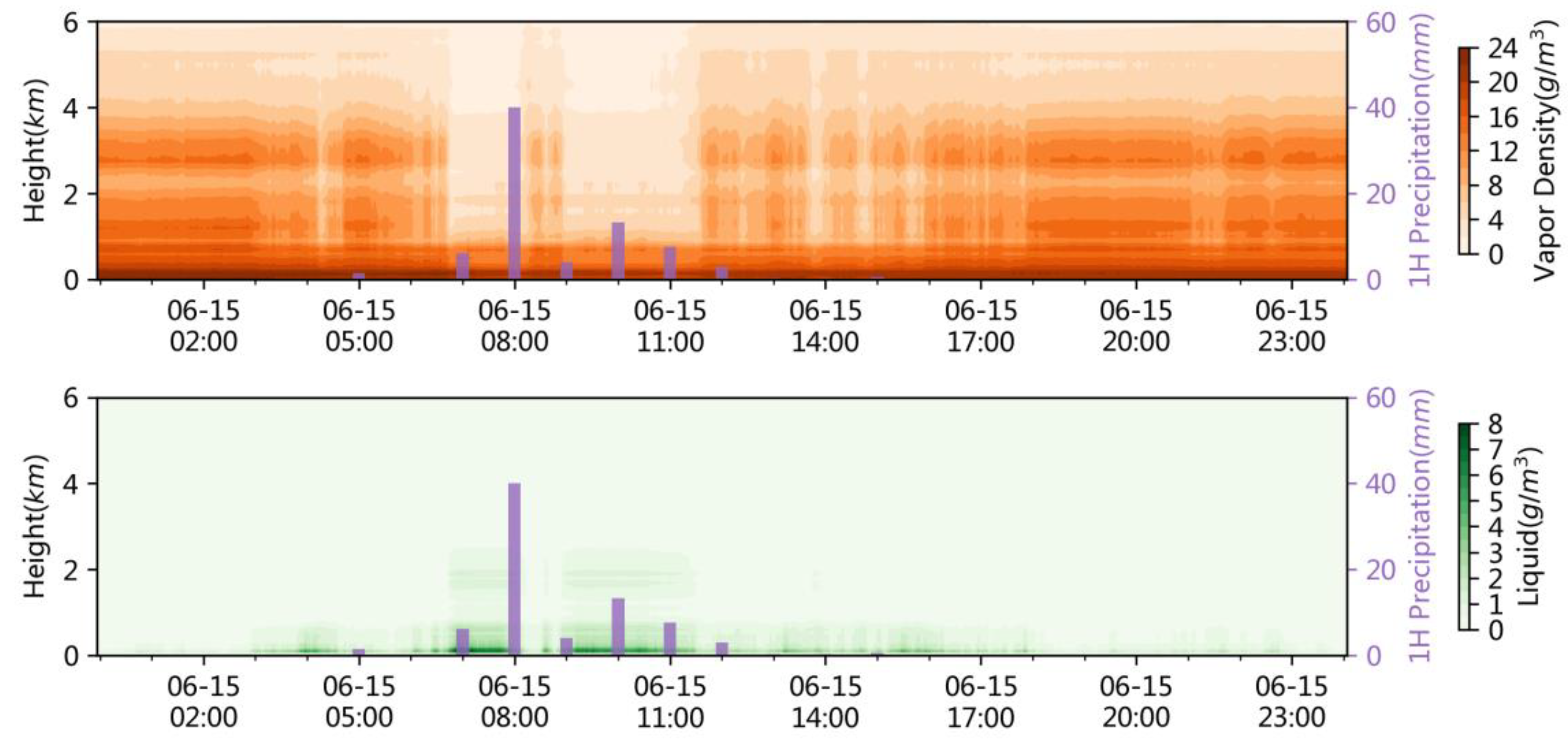
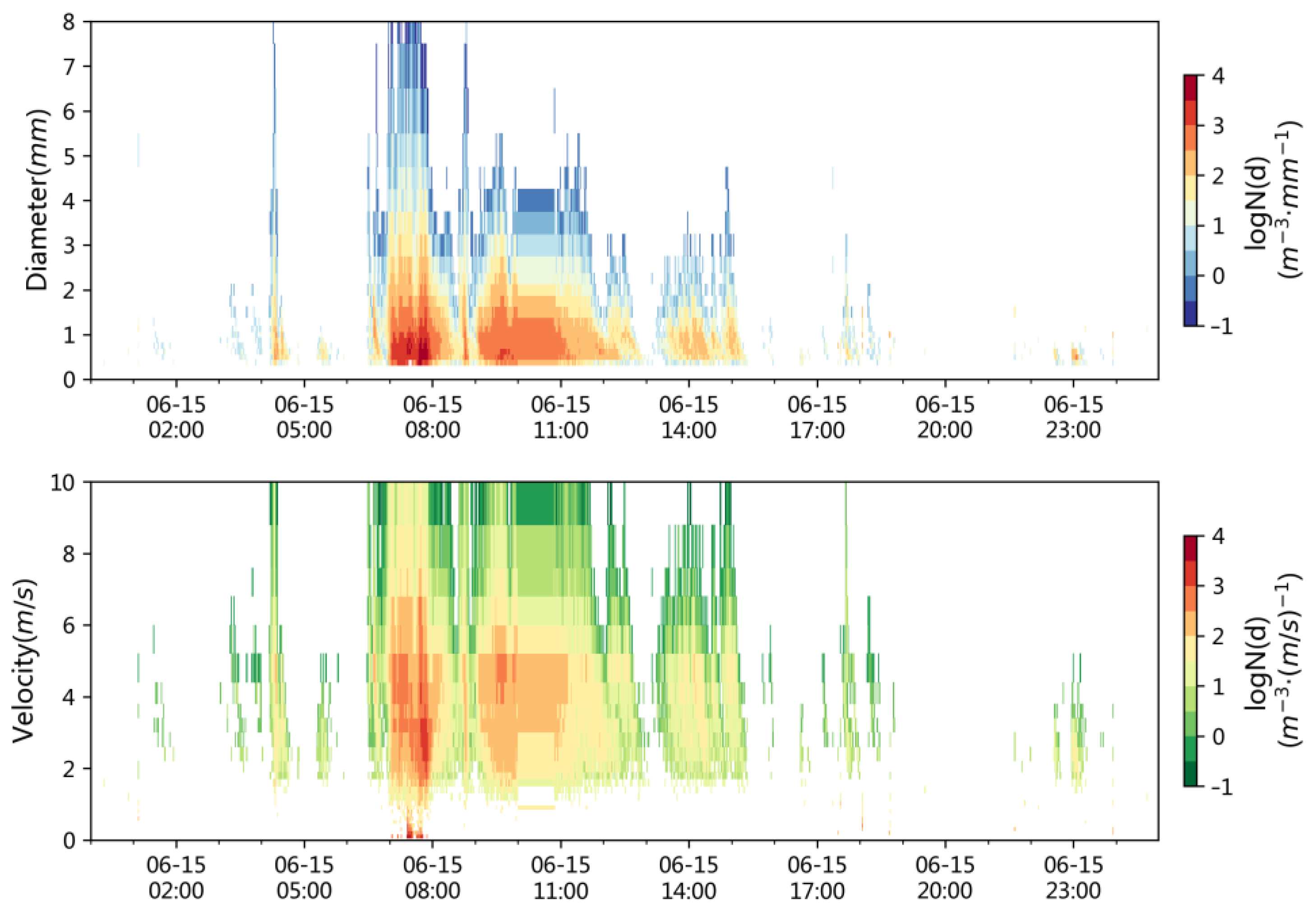
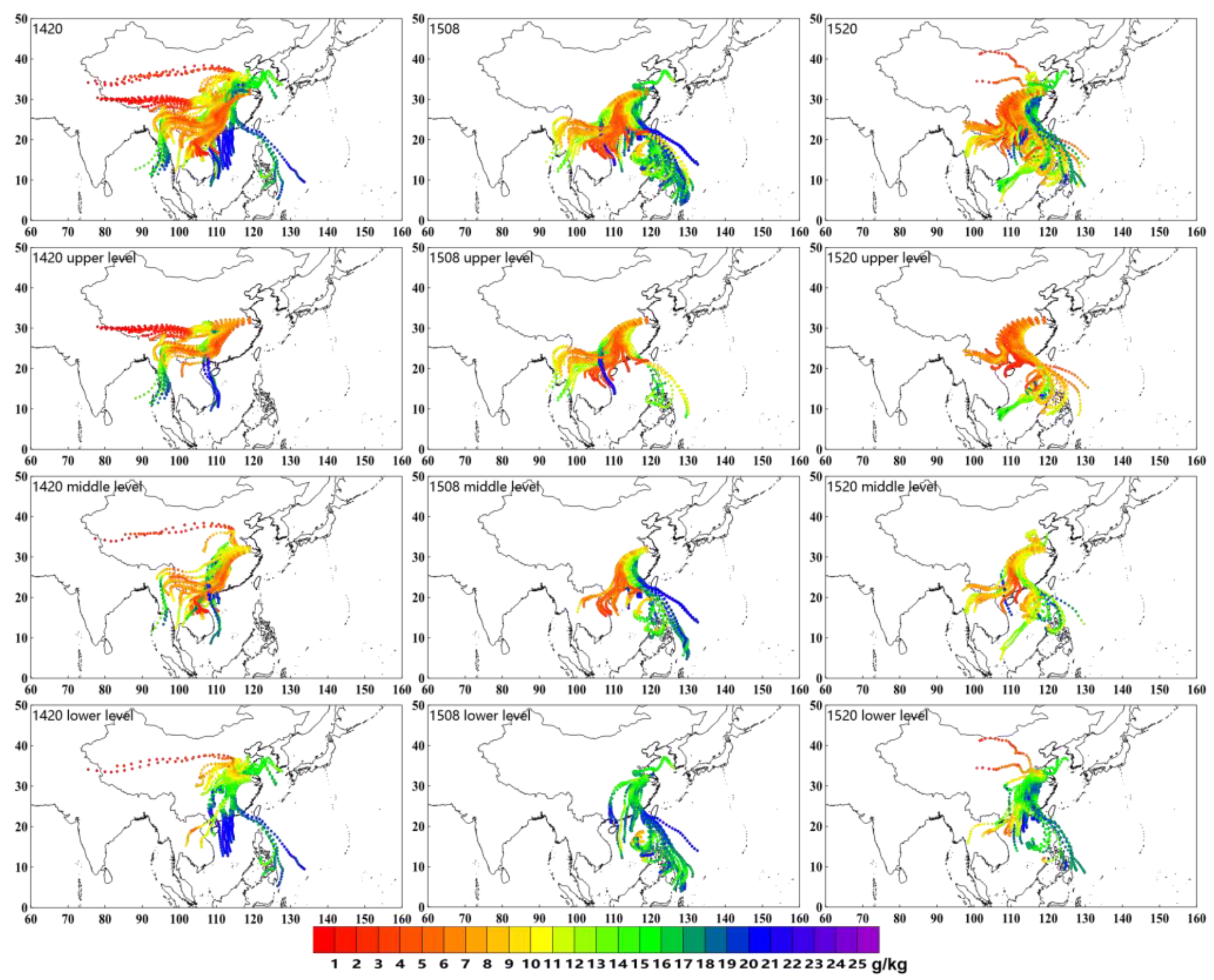
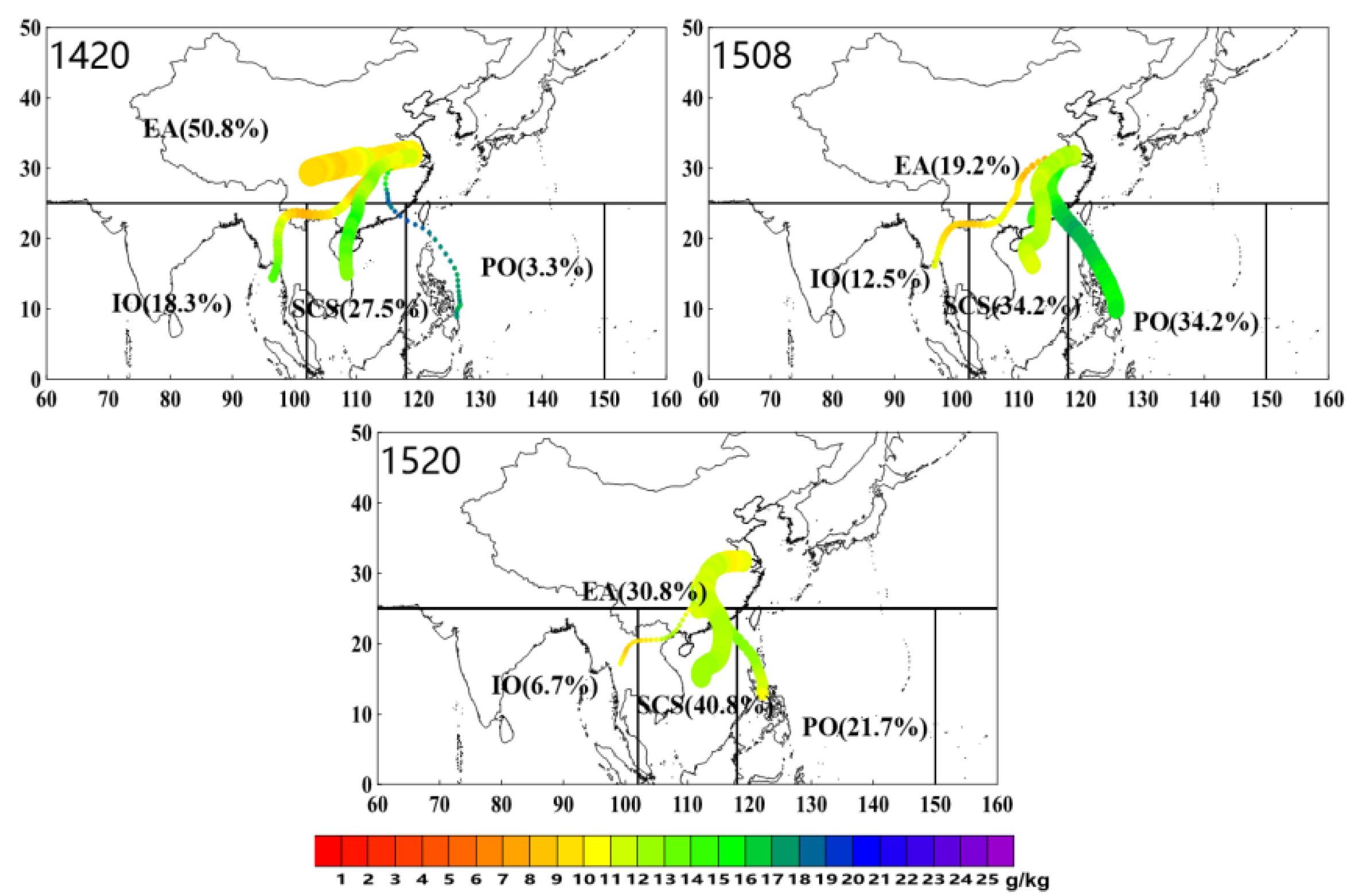

| Rainfall Intensity | 24-h Rainfall | 1-h Rainfall |
|---|---|---|
| light rainfall | <10 mm | <2 mm |
| heavy rainfall | ≥50 mm | ≥20 mm |
| Rainfall Intensity (Unit: mm·h−1) | R = 0 | 0 < R ≤ 5 | 5 < R ≤ 10 | 10 < R ≤ 20 | R > 20 |
|---|---|---|---|---|---|
| the average total column-integrated water vapor content (unit: mm) | 6.37 | 6.07 | 5.11 | 4.97 | 4.98 |
| the average total column-integrated liquid water content (unit: m) | 0.97 | 2.45 | 6.38 | 6.97 | 7.42 |
Disclaimer/Publisher’s Note: The statements, opinions and data contained in all publications are solely those of the individual author(s) and contributor(s) and not of MDPI and/or the editor(s). MDPI and/or the editor(s) disclaim responsibility for any injury to people or property resulting from any ideas, methods, instructions or products referred to in the content. |
© 2024 by the authors. Licensee MDPI, Basel, Switzerland. This article is an open access article distributed under the terms and conditions of the Creative Commons Attribution (CC BY) license (https://creativecommons.org/licenses/by/4.0/).
Share and Cite
Mao, Y.; Jiang, Y.; Li, C.; Shi, Y.; Qian, D. Analysis of a Rainstorm Process in Nanjing Based on Multi-Source Observational Data and Lagrangian Method. Atmosphere 2024, 15, 904. https://doi.org/10.3390/atmos15080904
Mao Y, Jiang Y, Li C, Shi Y, Qian D. Analysis of a Rainstorm Process in Nanjing Based on Multi-Source Observational Data and Lagrangian Method. Atmosphere. 2024; 15(8):904. https://doi.org/10.3390/atmos15080904
Chicago/Turabian StyleMao, Yuqing, Youshan Jiang, Cong Li, Yi Shi, and Daili Qian. 2024. "Analysis of a Rainstorm Process in Nanjing Based on Multi-Source Observational Data and Lagrangian Method" Atmosphere 15, no. 8: 904. https://doi.org/10.3390/atmos15080904
APA StyleMao, Y., Jiang, Y., Li, C., Shi, Y., & Qian, D. (2024). Analysis of a Rainstorm Process in Nanjing Based on Multi-Source Observational Data and Lagrangian Method. Atmosphere, 15(8), 904. https://doi.org/10.3390/atmos15080904





